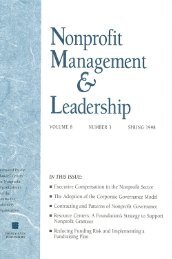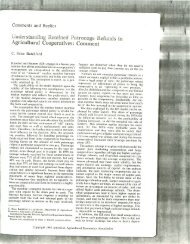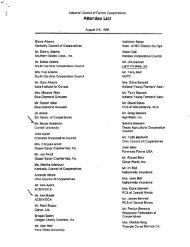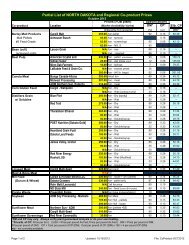Sunflower Production Field Guide - Your "Home Page"
Sunflower Production Field Guide - Your "Home Page"
Sunflower Production Field Guide - Your "Home Page"
You also want an ePaper? Increase the reach of your titles
YUMPU automatically turns print PDFs into web optimized ePapers that Google loves.
12<br />
be evaluated. Yield results from previous years on an<br />
individual’s farm and information from neighbors also<br />
are valuable. The best producing hybrids in a region<br />
may produce approximately 2,300 pounds per acre<br />
with good soil fertility and favorable soil moisture, or<br />
more than 3,000 pounds per acre in the most favorable<br />
growing conditions.<br />
Oil percentage should be another trait to consider in<br />
oilseed hybrid selection. Several environmental factors<br />
infl uence oil percentage, but the hybrid’s genetic<br />
potential for oil percentage also is important. Current<br />
hybrids have oil percentages ranging from 38 percent<br />
to more than 50 percent. Domestic oil processors have<br />
been paying a premium based on market price for<br />
more than 40 percent oil (at 10 percent moisture) and<br />
discounts for oil less than 40 percent. Current recommendations<br />
are to select a high-oil hybrid instead of a<br />
low-oil hybrid with the same yield potential, but don’t<br />
sacrifi ce yield in favor of oil content.<br />
Maturity and dry down are important characteristics to<br />
consider when deciding what hybrid to plant. Maturity<br />
is especially important if planting is delayed, being<br />
mindful of the average killing frost in your area. Yield,<br />
oil content and test weight often are reduced when a<br />
hybrid is damaged by frost before it is fully mature.<br />
An earlier hybrid likely will be drier at harvest than a<br />
later hybrid, thus reducing drying costs. Also, consider<br />
planting hybrids with different maturity dates as a production<br />
hedge to spread risk and workload at harvest.<br />
The most economical and effective means to control<br />
sunfl ower diseases and other pests is planting resistant<br />
or tolerant hybrids and considering a minimum<br />
of three to four years’ rotation between successive<br />
sunfl ower crops. Hybrids are available with resistance<br />
to rust, Verticillium wilt and certain races of downy<br />
mildew. New hybrids may be available with tolerance<br />
to Sclerotinia head and stalk disease. Growers should<br />
check with their local seed dealer or sunfl ower seed<br />
company representative to obtain this information.<br />
Stalk quality, another trait to consider, provides resistance<br />
to lodging, various diseases and other pests. Hybrids<br />
with good stalk quality are easier to harvest and<br />
yield losses generally are reduced, withstanding damages<br />
from pests and high winds. Uniform stalk height<br />
at maturity is another important trait to consider.<br />
Hybrid selection may include selecting a hybrid with<br />
resistance to certain herbicides not previously available.<br />
This nontransgenic resistance either was derived<br />
from the wild species of sunfl ower or from mutagenesis.<br />
Sunfl ower hybrids can be sprayed with herbicides<br />
that control various broadleaf and grassy weeds either<br />
by one chemical or by a tank-mix of two chemicals.<br />
This technology will allow broad-spectrum weed control<br />
in minimum-till or no-till sunfl ower production,<br />
as well as with traditional production. Growers should<br />
check with their local seed dealer or sunfl ower seed<br />
company representative to obtain information regarding<br />
availability of these hybrids.<br />
The last item to consider is to purchase hybrid seed<br />
from a reputable seed company and dealer with a good<br />
technical service record. This is particularly important<br />
if producers have any questions regarding production<br />
practices. Companies and seed dealers provide different<br />
services, policies and purchase incentives, including<br />
credit, delivery service and returns.<br />
Semidwarf Sunfl ower<br />
(Duane Berglund)<br />
Semidwarf sunfl ower is 25 percent to 35 percent shorter<br />
than normal height hybrid sunfl ower. Research results<br />
show seed yield and oil content of semidwarf and<br />
normal height sunfl ower are similar in some years but<br />
not always. In drought stress years, seed yield of semidwarf<br />
sunfl ower was signifi cantly less than normalheight<br />
hybrids. Most semidwarf sunfl ower have early<br />
maturity ratings, thus the potential for high yields is<br />
limited, compared with conventional-height sunfl ower.<br />
The semidwarf plant types appear to be less susceptible<br />
to lodging, which could be very important during<br />
years of optimum plant growth or where sunfl ower<br />
is grown under irrigation, in high-plant populations.<br />
Generally, the semidwarf sunfl ower can be planted<br />
in narrowly spaced rows or solid seeded. University<br />
research indicates root penetration and water use<br />
to a depth of 6 feet is similar for normal height and<br />
semidwarf sunfl ower. Beyond 6 feet, root penetration<br />
of the semidwarf may not be as great as that of taller<br />
plant types. Some sunfl ower breeders have observed<br />
that short-stature plants have demonstrated limitations<br />
in head size and ability of the plant to fi ll the center of<br />
the head. Also, slower seedling emergence has been<br />
reported for semidwarfs.







